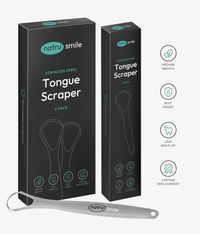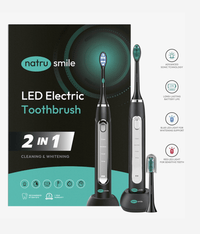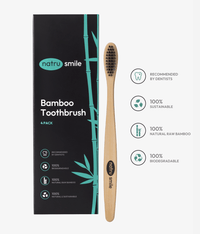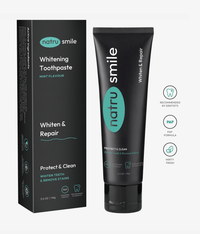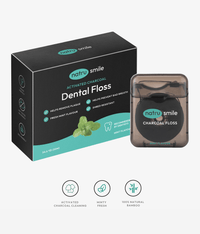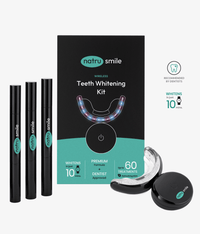
All products are certified by dental expert Dr. Greg Grillo
Have you ever woken up to find the skin around your mouth, nose, and eyes red, inflamed, and uncomfortable? You're not alone; this is an experience shared by countless individuals who suffer from a prevalent skin condition known as perioral dermatitis.
In this comprehensive guide, we will delve into the intriguing world of perioral dermatitis – unearthing its symptoms, uncovering its causes, and demystifying its treatments.
Not only that, but we'll arm you with invaluable knowledge on how to minimize your chances of developing this pesky skin issue in the first place. By understanding what sets it apart from other common skin problems and identifying early warning signs, you can take preventive measures to maintain your radiant complexion.
Let’s explore every nook and cranny so that you emerge well-equipped to tackle any skincare challenges head-on!
What Is Perioral (Periorificial) Dermatitis? An Overview
Perioral dermatitis, also known as periorificial dermatitis, is a skin condition characterized by red, inflamed, and sometimes itchy or painful bumps around the mouth, nose, and eyes. It is more common in women, especially those aged between 16 and 45 years old, but can also affect men and children. The exact cause of perioral dermatitis is still unknown, but several factors have been associated with its development.
Types Of Perioral Dermatitis
There are several types of perioral dermatitis, which can be classified based on the specific area affected:
-
Classic perioral dermatitis: This type affects the skin around the mouth, with small red bumps or papules forming around the lips' edges.
-
Perinasal dermatitis: This type affects the skin around the nose, with redness and inflammation occurring in the nostrils and the creases of the nose.
- Periocular dermatitis: This type affects the skin around the eyes, with red and inflamed bumps appearing on the eyelids, under the eyes, and the eyebrows.
Perioral Dermatitis Images
Images of perioral dermatitis can be found online through reputable medical websites and dermatology resources. The following images can help you identify and understand the appearance of perioral dermatitis.
Keep in mind that self-diagnosis is not a substitute for professional medical advice. If you suspect that you have perioral dermatitis, consult a dermatologist for an accurate diagnosis and appropriate treatment.
Perioral Dermatitis Symptoms
The symptoms of perioral dermatitis may vary from person to person, but they generally include:
- Red, inflamed bumps (papules) around the mouth, nose, and eyes
- Dry, flaky, or scaly skin in the affected area
- Mild to moderate itching or burning sensation
- A feeling of tightness or discomfort in the affected area
- In some cases, pus-filled bumps (pustules) may also be present
3 Healing Phases Of Perioral Dermatitis
The healing process of perioral dermatitis can be divided into three phases:
-
Inflammatory phase: This is the initial stage of perioral dermatitis, characterized by the appearance of red, inflamed bumps on the skin. This phase can last for several weeks or months, depending on the severity of the condition and the effectiveness of the treatment.
-
Healing phase: During this phase, the inflammation starts to subside, and the skin begins to heal. The redness and swelling decrease, and the bumps may start to disappear. This phase can also last for several weeks or months.
- Recovery phase: In this final phase, the skin has healed, and the symptoms of perioral dermatitis have resolved. However, the skin may still be sensitive, and proper skincare is essential to prevent a recurrence.
What Causes Perioral Dermatitis?
The exact cause of perioral dermatitis is still unknown, but various factors have been associated with its development. These factors include:
Steroids
-
Topical steroid creams: The prolonged use of topical steroid creams on the face can trigger perioral dermatitis, especially when used without a prescription or medical supervision.
- Inhaled prescription steroid sprays: Inhaled steroids used for treating respiratory conditions, such as asthma, have also been linked to the development of perioral dermatitis.
Lifestyle Choices
-
Moisturizers and heavy face creams: Overuse of moisturizers and heavy face creams on the face can lead to perioral dermatitis, as they can clog the skin's pores and cause irritation.
-
Fluorinated toothpaste: Some studies suggest that the use of toothpaste containing fluoride may contribute to perioral dermatitis, although this association is still not well-established.
-
Gum chewing: Constant gum chewing can cause friction and irritation around the mouth, potentially leading to perioral dermatitis.
- Dental fillings: Dental materials used in fillings, such as amalgam and composite resins, have been associated with perioral dermatitis in some cases.
Other
-
Hormonal changes: Hormonal fluctuations during menstruation, pregnancy, or the use of oral contraceptives can increase the risk of developing perioral dermatitis.
-
Dysfunction of the epidermal barrier: A compromised skin barrier can make the skin more susceptible to irritants and allergens, contributing to perioral dermatitis development.
-
Problems with the immune system: Individuals with weakened immune systems or autoimmune disorders may be more prone to perioral dermatitis.
-
Altered cutaneous microflora: Imbalances in the skin's natural bacterial flora can contribute to the development of perioral dermatitis.
-
Bacteria – follicular fusiform: Certain bacteria, such as Fusiform bacteria, have been found in the hair follicles of individuals with perioral dermatitis.
- Candida albicans: This type of yeast has also been associated with perioral dermatitis.
- Demodex mites: These microscopic mites live on the skin and have been found in higher numbers in individuals with perioral dermatitis.
Where Does Perioral (Periorificial) Dermatitis Most Commonly Occur?
Perioral dermatitis most commonly occurs around the mouth, nose, and eyes. It usually affects the skin around the mouth, extending up to the nose's creases, and around the eyes, including the eyelids and eyebrows.
Treatment Options For Perioral Dermatitis
The treatment of perioral dermatitis depends on the severity of the condition and the underlying cause. Some common treatment options include:
-
Topical and inhaled steroids: If the cause of perioral dermatitis is the prolonged use of topical or inhaled steroids, discontinuing their use is a crucial step in treating the condition. However, this should be done under medical supervision, as stopping steroids suddenly may worsen the symptoms.
-
Face creams: Avoiding heavy face creams and moisturizers may help alleviate perioral dermatitis symptoms. Instead, opt for lightweight, non-comedogenic, and fragrance-free products.
-
Cosmetics (makeup): Minimizing the use of makeup, especially around the affected area, can help reduce irritation and allow the skin to heal.
-
Sunscreen: Protection from the sun is essential, but some sunscreens can exacerbate perioral dermatitis. Look for non-comedogenic, fragrance-free sunscreens with physical blockers like zinc oxide or titanium dioxide.
-
Fluorinated toothpaste: If fluorinated toothpaste is suspected to be a contributing factor, switching to a fluoride-free toothpaste may help improve perioral dermatitis symptoms.
- Chewing gum: Reducing or eliminating gum chewing can help prevent irritation around the mouth and reduce the risk of perioral dermatitis.
Prescription medications, such as topical antibiotics, oral antibiotics, or topical calcineurin inhibitors, may also be prescribed by a dermatologist to treat perioral dermatitis.
Who Is At Risk Of Getting Perioral Dermatitis?
Perioral dermatitis is more common in women, especially those aged between 16 and 45 years old. However, it can also affect men and children. Factors such as hormonal fluctuations, weakened immune system, and exposure to irritants or allergens may increase the risk of developing perioral dermatitis.
Is Perioral Dermatitis Contagious?
Perioral dermatitis is not contagious in nature. This means that you do not have to worry about transmitting this particular skin ailment to others through direct physical contact or by sharing personal belongings and items.
Is Perioral Dermatitis A Fungal Infection?
Though perioral dermatitis may present itself with some similarities to fungal infections on the skin's surface, it is essential to understand that this condition is not primarily caused by fungi. In certain instances, there might be a connection between perioral dermatitis and Candida albicans – a common type of yeast found in our bodies. However, this association does not establish causation; rather, it merely indicates a possible link between them.
The main cause behind perioral dermatitis remains unidentified at present. Researchers continue to investigate various factors that could potentially contribute to its development, such as hormonal imbalances or even specific cosmetic products used on one's face.
Despite these ongoing studies seeking answers for its root cause(s), what we know for sure is that perioral dermatitis is neither contagious nor an infection caused solely by fungi like Candida albicans.
Can Perioral Dermatitis Become Rosacea?
Perioral dermatitis and rosacea are distinct skin conditions, each with their own unique characteristics, even though they may exhibit certain resemblances in terms of appearance and symptoms. Perioral dermatitis primarily targets the skin surrounding the mouth, nose, and eyes, while rosacea is more commonly found on the cheeks, nose, forehead, and chin.
It's important to note that it is possible for someone to simultaneously experience both perioral dermatitis and rosacea; however, having one condition does not automatically predispose an individual to develop the other.
Can Perioral Dermatitis Be Caused By Stress?
Stress has been known to play a role in initiating or exacerbating various skin disorders – perioral dermatitis being no exception. While there isn't sufficient evidence to support the notion that stress alone can directly cause perioral dermatitis, it's widely acknowledged that stress can have detrimental effects on an individual's overall well-being by weakening their immune system as well as disrupting their skin's natural protective barrier. Consequently, this leaves the skin more vulnerable to irritation from external factors such as allergens or environmental irritants.
Does Perioral Dermatitis Hurt?
Perioral dermatitis can cause discomfort, itching, or a burning sensation in the affected area. However, the severity of these symptoms can vary from person to person. In some cases, the symptoms may be mild and barely noticeable, while in others, they can be more severe and cause significant discomfort.
What Aggravates Perioral Dermatitis?
There are numerous factors that can exacerbate perioral dermatitis, a skin condition characterized by red, bumpy rashes around the mouth and nose. Understanding these triggers can help individuals manage their symptoms more effectively. The following list outlines some of the most common elements known to aggravate this condition:
-
Prolonged use of topical or inhaled corticosteroids: Long-term application of steroid creams or inhalants on the affected area might provide temporary relief but can ultimately worsen perioral dermatitis over time.
-
Overuse of heavy face creams or moisturizers: Applying excessive amounts of thick lotions or facial products may lead to clogged pores and contribute to inflammation, thereby exacerbating the symptoms associated with perioral dermatitis.
-
Exposure to irritants or allergens: Certain substances like harsh soaps, cosmetics, fragrances, and even dental products can cause irritation and allergic reactions on sensitive skin. These irritants may trigger flare-ups in individuals suffering from perioral dermatitis.
-
Hormonal fluctuations: Changes in hormone levels during events such as menstruation, pregnancy, or menopause have been linked with an increase in inflammation and skin sensitivity; this could potentially intensify signs of perioral dermatitis for some people.
-
Stress-related effects on immunity and skin health: High stress levels are known to weaken our immune system's ability to fight off infections while also disrupting our skin's natural barrier function. Individuals experiencing elevated stress might notice a worsening effect on their existing perioral dermatitis symptoms.
- Environmental factors influencing skin integrity: A variety of external conditions may play a role in aggravating perioral dermatitis as well. For instance, extreme temperatures (both hot and cold), fluctuating humidity levels, exposure to sunlight (particularly UV radiation), and windburns – all these factors have the potential to compromise the skin's protective barrier, thus making it more susceptible to inflammation and irritation.
By being aware of these factors and taking appropriate preventive measures (such as using gentle skin care products, managing stress levels, avoiding known irritants, and protecting the skin from harmful environmental elements), individuals suffering from perioral dermatitis can potentially minimize flare-ups and improve their overall skin health.
Is Perioral Dermatitis Permanent?
Perioral dermatitis is not a permanent condition, and with proper treatment, it can be effectively managed and resolved. However, the healing process can take several weeks or months, depending on the severity of the condition and the effectiveness of the treatment. It is essential to follow your dermatologist's advice and maintain a consistent skincare routine to prevent recurrence.
How Is Perioral Dermatitis Diagnosed?
Perioral dermatitis is typically diagnosed through a physical examination and a review of your medical history by a dermatologist. The doctor will examine the affected skin and ask questions about your symptoms, lifestyle habits, and any medications or products you have been using. In some cases, a skin biopsy may be performed to rule out other skin conditions with similar symptoms.
Should I See A Dermatologist?
If you suspect that you have perioral dermatitis or are experiencing persistent skin problems around your mouth, nose, or eyes, it is essential to consult a dermatologist for an accurate diagnosis and appropriate treatment. A dermatologist will assess your condition and recommend the best course of treatment based on your specific needs.
How Can I Reduce My Risk Of Perioral (Periorificial) Dermatitis?
There are several steps you can take to reduce your risk of developing perioral dermatitis, including:
- Avoiding the prolonged use of topical or inhaled steroids, unless prescribed by a doctor
- Using gentle, fragrance-free cleansers and skincare products
- Minimizing the use of heavy face creams and moisturizers
- Avoiding potential irritants, such as harsh soaps, cosmetics, and fragrances
- Managing stress through relaxation techniques, exercise, and a healthy lifestyle
- Protecting your skin from excessive sun exposure by wearing a broad-spectrum sunscreen and protective clothing
What Medicines Can I Take To Prevent Perioral Dermatitis?
There are no specific medications designed to prevent perioral dermatitis. However, some prescription medications, such as topical antibiotics, oral antibiotics, or topical calcineurin inhibitors, may be prescribed by a dermatologist to treat existing perioral dermatitis and prevent recurrence.
How Long Will I Have Perioral (Periorificial) Dermatitis?
The duration of perioral dermatitis varies from person to person and depends on the severity of the condition and the effectiveness of the treatment. In some cases, perioral dermatitis may resolve within a few weeks, while in others, it may take several months for the symptoms to improve.
Can Perioral Dermatitis Go Away On Its Own?
In some cases, perioral dermatitis may resolve on its own without treatment. However, it is essential to consult a dermatologist for an accurate diagnosis and appropriate treatment to ensure the condition does not worsen or recur.
Can Perioral Dermatitis Get Worse?
If left untreated or not properly managed, perioral dermatitis can worsen over time, leading to more severe symptoms and discomfort. It is crucial to follow your dermatologist's advice and maintain a consistent skincare routine to prevent the condition from getting worse.
Perioral Dermatitis Vs Acne
Perioral dermatitis and acne are two different skin conditions, although they may share some similarities in appearance. While perioral dermatitis primarily affects the skin around the mouth, nose, and eyes, acne can occur on various parts of the body, including the face, chest, and back. Acne is characterized by the presence of blackheads, whiteheads, and pimples, while perioral dermatitis presents as red, inflamed bumps.
Best Antibiotics For Perioral Dermatitis
The choice of antibiotics for treating perioral dermatitis depends on the severity of the condition and the patient's specific needs. Some commonly prescribed antibiotics for perioral dermatitis include:
- Topical antibiotics, such as metronidazole, erythromycin, or clindamycin
- Oral antibiotics, such as tetracycline, doxycycline, or minocycline
It is essential to follow your dermatologist's recommendations and complete the prescribed course of antibiotics to ensure the effective treatment of perioral dermatitis.
Can Allergies Cause A Rash Around The Mouth?
Allergic reactions to certain substances, such as foods, medications, or skincare products, can cause a rash around the mouth. However, an allergy-induced rash may have a different appearance and pattern than perioral dermatitis. If you suspect that an allergy is causing a rash around your mouth, consult a dermatologist or allergist for an accurate diagnosis and appropriate treatment.
What Is A Red Rash Around The Mouth?
A red rash around the mouth can be caused by various factors, including perioral dermatitis, allergic reactions, contact dermatitis, or other skin conditions. It is essential to consult a dermatologist for an accurate diagnosis and appropriate treatment if you are experiencing a persistent red rash around your mouth.
Can Drooling Cause A Rash Around The Mouth?
Drooling, especially in infants and young children, can cause skin irritation and a rash around the mouth. This type of rash is typically caused by the moisture and friction created by saliva, which can lead to skin irritation and inflammation. Keeping the skin clean and dry and using a barrier cream can help prevent and treat a drool-induced rash around the mouth.
Can Cinnamon Cause A Rash Around The Mouth?
Cinnamon, a common spice used in various foods and products, can cause a rash around the mouth in some individuals, especially those with a cinnamon allergy or sensitivity. This type of rash is typically characterized by redness, itching, and irritation around the mouth and lips.
Can Toothpaste Cause A Rash Around The Mouth?
Certain ingredients in toothpaste, such as fluoride or flavorings, can cause a rash around the mouth in some individuals. If you suspect that your toothpaste is causing a rash around your mouth, try switching to a different brand or a toothpaste formulated for sensitive skin.
Can Tomatoes Cause A Rash Around The Mouth?
Tomatoes, along with other acidic foods, can cause a rash around the mouth in some individuals, especially those with sensitive skin or a tomato allergy. This type of rash is typically characterized by redness, itching, and irritation around the mouth and lips.
Can Saliva Cause A Rash Around The Mouth?
Saliva can cause a rash around the mouth, especially in infants and young children who drool frequently. The moisture and friction created by saliva can lead to skin irritation and inflammation, resulting in a rash around the mouth. Keeping the skin clean and dry and using a barrier cream can help prevent and treat a saliva-induced rash.


